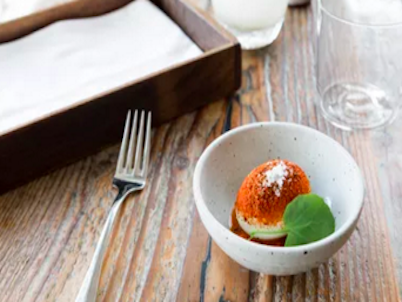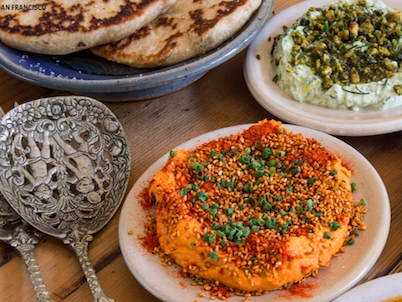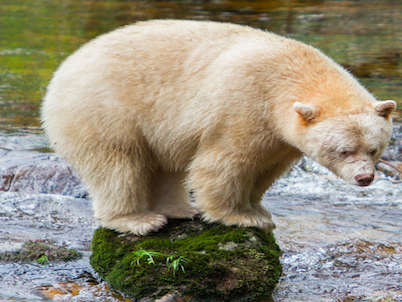It’s well into Day Two, and people are wet and cold and starting to worry. “I’m concerned,” says Carol, crinkling her nose.
We’ve spent the past three hours floating quietly on a small Zodiac raft in the salmon-filled Kinoyuk Inlet, then bushwhacking in borrowed gumboots beneath hemlock trees heavy with moss. All of it in the rain. And still: no bears.
“What if we don’t see any?” says Carol, clearly annoyed it’s taking this long.
She’s been everywhere from Iran to Gabon to “all the –stans,” and now she’s here, on a sailboat in remote northern British Columbia, in the Great Bear Rainforest, wearing a waterproof cape, for one reason: bears. Black bears, brown bears, and in particular, the Spirit Bear: an extremely rare, elusive white-furred black bear found only on this remote archipelago of mostly uninhabited islands.
Marci and Marc’s spirits have yet to be dampened. They have saved five years for this trip of a lifetime. They also have matching M&M tattoos (“like the candy”) and camera lenses the size of telescopes. “Marc is always hoping to see bears on any hike we take,” says Marci. “Booking this trip almost guarantees seeing them!” adds Marc. “When I was younger, I admired bears’ beauty, size, ferociousness,” he says. “Now, I look at bears as one of the smartest creatures on earth. They don’t get caught up in life’s trivial things like we do. They’re all about survival, nurturing their young, teaching them to take care of themselves, that’s it. They live a simple life.”
And this week, so do we. Here, biding our time among fjords and estuaries and islands. At 21 million acres, Great Bear is the largest coastal temperate rainforest in the world, alive with 1,000-year-old western cedars and 4,000-foot waterfalls, a scattering of First Nations communities who’ve lived here for 9,000 years—and more wildlife than annual visitors. An unspoiled swath of our otherwise increasingly spoiled planet, accessible only by boat or float plane.
Consider this British Columbia’s answer to the African safari, only with grizzlies in lieu of elephants and humpbacks instead of hippos.
*
The night before, our first aboard the Maple Leaf, all eight of us squeezed thigh-to-thigh around the galley’s mahogany table, drinking wine and dining on almond-encrusted Coho salmon as the ship’s captain, Greg Shea, asked us to share our “wildlife expectations.” Apart from a penchant for nature photography and zip-off pants, this motley crew—ranging in age from 32 to 82, from Seattle to Switzerland to both coasts of Canada—has little in common other than a desire to commune with bears.
These nice but clearly crazy people I’m with for the next 192 hours or so want to see them all. All day. Every day. Up close. A pack of coastal wolves, they all agree, would be super cool, too.
They’re certainly in the right place. In 2016, legislation was finally passed to protect 85 percent of this 6.4 million-hectare old-growth forest from logging. And on November 30 of last year—thanks to the work of conservationists and the indigenous First Nations communities—the state of British Columbia completely banned trophy hunting of grizzly bears. The First Nations had already banned trophy hunting back in 2012 in their traditional rainforest lands, and our captain explains that means more bears. Lots of bears.
Plus, they’re less skittish than they used to be, now that they’ve learned people aren’t out to kill them. “Bear-watching has been better than ever!” beams Captain Greg, his blond curls spilling out of a faded Maple Leaf cap that reads “Small Ship, Big Adventure.” Expectedly ruddy, with a genuine perma-grin, capable hands, and a calm, confident demeanor, he is for sure the kind of guy I want to be with if —when?—I do see a bear.
*
The Great Bear Rainforest isn’t exactly on the honeymoon circuit. And with a bunkroom for eight, two small “heads” (ship speak for toilets), and one shower per person—all week—neither is the Maple Leaf.
It is, however, one of the most beautiful old wooden boats you’ve ever seen. The 1904 schooner used to haul halibut, before it was spiffed up for eco-tourism trips. It’s the kind of ship you’d find inside a bottle, a masterpiece of Douglas fir and yellow cedar. Wifi? Nope. Nine whole days without it.
But there are two walking Wikipedias on board: Captain Greg and naturalist Brandon Harvey, who know everything there is to know about the Great Bear Rainforest—its crannies and its creatures.
There’s also a hardworking crew ready to hoist sails and pour coffee and replenish TP as needed, as well as a talented chef who cooks four meals a day from scratch, including not one, but two breakfasts (7a.m., granola, muffins; 9a.m., frittatas, French toast); steamy bowls of lentil stew or beef chili for lunch; two hardy midday snacks; and a three-course supper.
There’s no casino, no lounge show, no midnight buffet. Bedtime follows soon after dessert. It’s up-anchor by 6am, after all.
The cabin is tighter quarters than a freshman dorm room, with as much privacy as a rock band’s tour bus. Only a curtain separates each of the four double bunks, which means, despite the provided earplugs, you get to know the nighttime noises of people you just met. I learn that Marc, a hulk of a man, snores like Fred Flintstone. And that Carol calls out in her sleep. And that Doug and Jean, a sweet, silver-haired couple who’ve been married for 56 years, whisper to each other in French before kissing goodnight.
Still, a trip aboard the Maple Leaf is supposed to be about observing wildlife, not fellow passengers. We just have to be patient, the captain reminds everyone. This is nature, not a zoo.
*
Before arriving here, I assumed that everyone—other than the lunatic profiled in Werner Herzog’s 2005 film, Grizzly Man—was afraid that a 900-pound carnivore might maul them to death. When I booked this bear watching trip, I kind of hoped it would be from the deck of our boat, with, like, really good binoculars.
Not exactly what the Maple Leaf has in mind.
We would be landing on terra firma, walking on shore, along the banks, even, at times, through the woods. Be quiet, we were told. Walk slowly, as a group—no straggling behind! We look bigger together than we do alone, Captain Greg explained. All food stays back on the boat, of course.
After that brief training, I felt (sort of) prepared to meet a towering, hungry bruin on its home turf. I also felt a surge of excitement (mixed with sheer fear), the first time we stepped into the inflatable Zodiac and motored toward shore. But since then, things have slowed down.
Wildlife isn’t something you can just summon On Demand, like Planet Earth II. In this age of Google Express and Amazon One-Hour Delivery, a world where everything from filet mignon to organic marijuana to a personal masseuse can arrive at our doorstep with a single swipe, it’s no surprise we’ve become a society of virtual Veruca Salts. We want what we want and we want it now. Instant gratification has grown so expected that when our favorite podcast pauses to buffer or Uber cites “12 minutes until arrival,” it’s cause for distress. Twelve minutes! An eternity!
It’s sad, but true: We’ve forgotten how to wait. Especially, god forbid, without an iPhone in our hands to keep us occupied. Yet here in the Great Bear, wait times, I find, are on a scale of hours and days, not minutes.
*
When not cruising the inlets on a futile hunt for bears, we roam aimlessly around the ship, from the wheelhouse to the galley to the head to our bed, as we wait—for the rain to stop; for a whale to breach; for the anchor to drop; for the sugar cookies to come out of the oven.
As we make our way further north to Mussel Bay, the rain does stop for a spell, and I start to realize that maybe just hanging around waiting—for something, anything, to happen—isn’t so bad.
Not when you’re cruising slowly through serene waters, gazing up at granite walls carved out by glaciers 12,000 years ago and bald eagles presiding from treetops, and waterfalls cascading into the sea. Which, I notice, is a soft gray today, almost indistinct from the sky. There’s also not a single boat, let alone another sign of civilization, in sight.
*
Just before supper on Day 3, we give it another go. We climb down the boat’s wooden steps and pile back into the Zodiac. We zoom out to the estuary, where we crouch in our gumboots and wait on the grassy, wet bank. We don’t make a sound. We listen and look, hoping to hear the crack of a tree branch or spy a movement in the brush. Time passes. Eventually, not one—but freaking four—grizzlies wander down to the water.
I whisper Oh My #@&%ing God and inch closer to Captain Greg. And watch: They’re only cubs, but they’re massive; ambling on all fours through the shallow water, searching for supper. My visit happens to fall in September, prime salmon time, so they find it, no problem. They prowl the shoreline—then pounce, tearing into the pink flesh of the belly as blood and guts plop back into the water. Then they go back for more.
Somehow two hours pass, and at some point I start to relax. A little. I’m captivated. You can’t really get bored watching bears, because, you know, you’ve got to stay alert. They eat and wade through the waist-deep water, they inch closer to our side of the bank—until we’re standing less than 20 feet from them, snapping photos like paparazzi. And yet they barely register our existence. Apparently all they want is fish. Phew.
*
The next afternoon, we head out on the Zodiac and quietly clamber out as Greg points to a big brown furry mound on a grassy slope: four bears napping, a mama and her three cubs. We sit on the bank in our supposedly rainproof pants, watching bears sleep for almost an hour.
My butt is getting damp, my hands are getting cold, and I’m getting ready to head back to the Maple Leaf for a glass of wine. But Captain Greg is engrossed. He has no idea what’s about to happen, but he’s well-versed in the ways of the wild—he knows what we eventually come to learn: that if you wait long enough, something will.
And something does. All of a sudden, mama bear’s mammoth body starts to move. She lumbers onto her back, nipples up, torso outstretched like a limo, and props herself on her elbows (if bears have elbows?). Her three cubs nuzzle close. At first it looks like they’re just cuddling, until we realize, wait, no— they’re suckling. It hits us that we are sitting in the mud in the middle of nowhere, WATCHING A MOTHER GRIZZLY NURSE HER CUBS. Even Captain Greg is gawking at our good luck. Despite a decade observing bears, this is a first for him, too. We’re mesmerized, even a little embarrassed to witness such an intimate, primal moment.
But like any forthright feminist, mama doesn’t mind. This is what we do, she seems to say. The cubs pull off. Milk dripping from their snouts, they look right at us then saunter off into the trees.
What if we’d bailed before the bears woke up? Proof, people, that patience pays off.
*
In the days that follow, the fog parts and the sun shines. Beneath cloudless, electric-blue skies, we cruise up Princess Royal Channel—alongside breaching whales and dancing dolphins, barking sea lions and swimming deer (what? yeah).
We scatter ourselves around the deck, reading, journaling, talking, not talking, leaping up whenever Brandon spies a whale spouting in the distance—and we wait, cameras poised, ready to capture the perfect whale tail. Or two. “It’s a double breach!” Sara, a self-proclaimed whale fanatic, squeals in her thick Swiss-German accent. Once the whale action subsides, we resume our lazy positions and watch the screensaver-worthy landscape roll by.
Every so often, someone in a sun hat wanders by on their way to the bow or the stern and can’t help but say: “It’s so beautiful, isn’t it?” Because it is.
In between kayaking around estuaries and soaking in hidden hot springs, jumping off the bowsprit into BC’s ice-cold sea and barbecuing pork loin over a sunset bonfire on a deserted beach, we zip around in the Zodiac in search of bears.
We find them almost too easily now: Bears chasing fish. Bears chomping fish. Bears sloshing through a marsh. Brother bears wrestling like little boys. Bears standing on their hind legs, arms around each other, like two best friends posing for a picture.
*
Day 5, we unload at Gribbell island, home to the sacred spirit bear—or at least a handful of the only 100 or so estimated to be in existence. We follow a man named Garnet, of the Gitga’at Nation, to a small wooden platform tucked in the trees, a few feet above a rocky river. Along the way, chef Tom picks angel wing mushrooms to cook up later for dinner.
“My last group waited 11 hours,” warns Captain Greg. “We can stay as long as it takes.” It’s 7:30 a.m. We could be here until dinnertime, he says, and still never see one. Bring it on, I say to myself.
We peer upriver. We peer downriver. Then upriver again. Then downriver again. Kingfishers flutter above. Salmon flutter below. A jet-black bear wanders by and bats at some breakfast.
A good three hours pass before we spy him: a ginormous, cream-colored marshmallow slowly making his way up river: a spirit bear. Not just any spirit bear, apparently, but “Big Boss,” as dubbed by Garnet.
As he gets closer, I wonder if he knows he’s an anomaly. The fringe benefit of his rare mutation: Salmon can’t see white bears as well as they can black or browns. That probably explains his healthy bulk. I wonder if he knows we’ve been waiting all morning for him, all week for him. Heck, Carol’s been waiting her whole life for a glimpse of him. He has no sense of his celebrity. He eats his lunch, then moseys up river.
Spirit bear sighting box checked, we could easily leave, head back to the boat. But why? We know better by now. We wait.
And indeed, a few hours later, Big Boss comes back. He sees a black bear fishing on his turf and he isn’t happy. Next thing we know, it’s a full-on bear fight—right beneath our feet. The white bear rams over the mossy rocks, like a Mac truck on the loose, coming at the black bear from behind—and slamming him so hard we can hear their bodies crash above the rushing river. They huff and grunt and push and shove, water splashing, until eventually, true to his nickname, Big Boss triumphs.
It’s like the Nature Channel come to life, and in a matter of minutes, the show’s over as quickly as it began. Apparently, an IMAX crew has been hanging around Great Bear for weeks hoping to catch this kind of action, boasts Greg. And we just happen to see it in the flesh—after a mere five-hour wait.
Toward the end of the trip, I decide to skip the morning safari and take a kayak out for a solo morning paddle instead. After a week on a motor-powered sailboat, I need a little human-powered movement. I need a little alone time.
Until I look ahead and see my fellow passengers sitting in the Zodiac staring at a spit of land. They’ve been sitting perfectly still for at least a half-hour. Curious, of course, I quietly move toward them—and then I hear it, too: the howling of wolves in the wild. It’s haunting. And humbling.
Back at the boat, at second breakfast, the rest of the party is giddy: They actually saw the coastal wolf. A rare sighting, rarer than even the spirit bear. Brandon feels elated after a lifetime spent looking. Carol announces she sure got her money’s worth. Marc gives Captain Greg a big bear hug. And me? I feel like I missed out. I was impatient. I paddled away too soon.
But then I realize: Aren’t we always missing it? The wolves and the whales, the bears and the birds, all living their lives in the wilderness while—a world away—we live ours?
Tomorrow, I’ll say goodbye to the bears and Big Boss, to the sunsets and stars. .I’ll be heading back to laptops and Netflix, to traffic and take-out Thai food. I’ll leave the Maple Leaf bobbing by the dock and catch a ride to the tiny airport in Bella Bella. I’ll take a seat in the one-room terminal, and wait.
And wait. And wait. “Flight’s been delayed,” the man next to me will say. I will look around: at the unstaffed counter selling nothing but coffee. At the two fishermen chatting in their plastic chairs. At the little boy slumped beside his mom.
I will try my best to be in the moment, to be the wilderness sage I’ve become, and wait patiently for whatever’s next.
Which, unfortunately, will not be my plane. And then, like the typical 21st century human I still am, I’ll reach for my iPhone, and hope the Wifi works. I will want to send my family photos of Big Boss and the wrestling brothers and the nursing cubs—knowing full well that a picture won’t do them justice.
Getting Here
A trip to the Great Bear Rainforest aboard the Maple Leaf ($3,450 for 8 nights in spring, $5,250 for 7 nights in fall; mapleleafadventures.com) begins and disembarks in Bella Bella, BC, a short flight from Vancouver. The cost includes all meals, wine or beer, accommodations, gumboots, and guiding. Trips to see the spirit bears only take place in September and October, and they often sell out months in advance—so if you want to see one of the 100-or-so spirit bears on planet earth, and watch grizzlies munching on fish during the autumn salmon runs, best to lock in an autumn trip soon. Maple Leaf Adventures also runs a boat called the MV Swell, a gorgeous restored tugboat, and this season, has added a third boat to its fleet: the Cascadia, a luxury catamaran.
Rachel Levin is the author of LOOK BIG: And Other Tips for Surviving Animal Encounters of All Kinds, published by Ten Speed this month.





